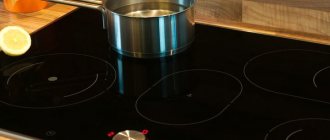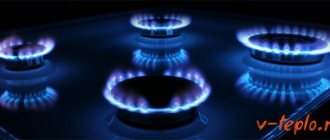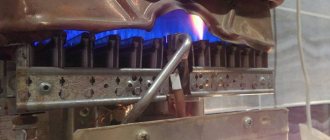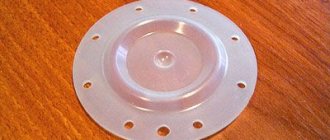Types of hobs
Gas
Such hobs are traditionally more expensive than electric ones, but this purchase is definitely profitable.
This is all thanks to the difference in tariffs for blue fuel and energy - gas is much cheaper. And even if your house is not connected to the central highway, it is quite possible to use a balloon one. Pros:
- Cheaper to operate;
- High heat output of the burners – food cooks faster;
- You can use almost any utensil;
- Smooth flame adjustments;
- No need to wait for the stove to heat up.
Minuses:
- Fire hazard;
- Air pollution in the kitchen by combustion products;
- Soot forms on dishes faster.
Unfortunately, city residents whose apartments are located above the 10th floor cannot use gas panels - building and fire codes directly prohibit this.
Electrical
Modern electric stoves look much nicer than their predecessors with open spirals or cast iron pancakes. They fit perfectly into the interior of any kitchen, which is why housewives especially love them.
In addition, manufacturers offer a variety of heating options for electric burners hidden under glass or glass ceramics. So it will not be difficult to choose the right model for your needs.
Pros:
- Safer than gas stoves because there is no open flame;
- Impeccable appearance;
- Convenient – both in work and in care;
- Wide range of control options – up to recipe programming;
- Large set of automatic protections;
- The presence of a hood is not strictly necessary.
Minuses:
- They are not cheap to operate because they consume a lot of energy;
- Requires a separate three-phase line;
- The need to keep the surface perfectly clean and use dishes with a flat bottom.
Combined
These stoves are equipped with both gas and electric burners. An excellent option for homes where there are frequent power outages or where you have to use bottled gas.
Pros:
- Possibility to cook on gas when there is no light, and vice versa;
- More economical than purely electric models;
- There are no special problems with the selection of dishes;
- They often have additional heating surfaces - for example, for barbecuing.
Minuses:
- High price;
- Particularly strict installation rules;
- They combine all the disadvantages of gas and electric panels.
Electricity consumption
When determining how much electricity will be consumed by the hob, various factors are taken into account. The first is power consumption in kW. The second is the number of hours during the day or month that the stove is on.
Uneven usage makes it difficult to accurately measure this value. But there are average indicators for determining monthly consumption.
How much electricity is consumed per month
Energy classes
Among the parameters by which a hob is selected, energy consumption is one of the main ones. When determining it, it is not the performance of individual burners that is taken into account, but the total electricity consumption per month. According to this indicator, an induction cooker is superior to other types of kitchen appliances.
Average standards for a model with a total productivity of 3.5 kW are 1.3 kW per hour. Turning on the equipment daily for 2 hours leads to a consumption of 2.6 kW per day. Consumption during the month is about 80 kW. For powerful 7-megawatt equipment, up to 160 kW is spent per month.
Consumption depends on three factors. The first is the performance of the burners. The second is frequency of use.
The third is the equipment energy consumption class. It is designated by Latin letters - from A to G. The best options are with class A+, A++ or A+++. Savings when using such cookers will increase by another 20-40%.
Features of liquefied fuel
Liquefied gas is not cheaper than natural gas; it is used if there is no centralized pipeline.
Liquefied gas is produced by converting it from a gaseous to a liquid state. During the conversion process, the fuel is cleaned of any excess impurities and cooled to form condensate. In this case, the volume of material is reduced by 600 times. The fuel is stored in special cylinders, which are connected to the heating unit. This option for heating a house is used if it is not possible to connect to a centralized heating network.
The consumption of liquefied gas is influenced by all the same factors as its gaseous form. The hourly rate of fuel consumption in liquid form for a 10 kW device is 0.86 cubic liters. If the power is 30 kW, the flow rate increases to 2.58 cubic liters. at one o'clock.
Comparison of power of different types of stoves
The power ratings of a gas stove are higher than those of other options. Its burners produce from 1 to 3-4 kilowatts. However, this does not provide gas with serious advantages. When converted from kW to rubles, the operating costs of induction equipment are similar.
The performance of a conventional electrical appliance reaches 5.5 kW. Induction models consume about 7 kW. The Power Boost function can increase the parameter up to 10 kW.
However, an electric stove will take 2-4 times longer to heat up. Therefore, with equal or even lower productivity, energy consumption is higher.
This becomes especially noticeable when comparing monthly consumption, which reaches 300-500 kW for electrical devices.
By comparing the performance of different models, conclusions can be drawn. Gas technology remains the most profitable and powerful.
But the savings are small. Moreover, induction models benefit in terms of safety, speed, and ease of use. Electric stoves with lower productivity are considered the most inefficient.
Which stove to choose
Also, the choice of meter and method for calculating gas consumption by a stove is influenced by factors such as:
- Number and power of burners. For example, if you don’t need to cook meals all day for a large group/family, a model with 2 low-power burners will suit you. And then you will need an inexpensive control device. With a 4-burner it is a little more difficult.
- Method of operating the stove.
- Number of residents and their habits.
- Time of year and season. For example, in winter frosts, gas heating takes approximately 300 cubic meters. liquefied gas. In summer - 30-40 cubic meters. And about 10% is gas waste due to burners. The other 90% is spent on water. And in such situations, such a stove consumes 3-4 cubic meters per month. fuel.
Features of installation of the accounting device
Installation of the meter must be carried out exclusively by specialists with appropriate qualifications; compliance with the required installation standards and requirements is mandatory. As for the cost of installation work, it depends on a number of individual features, including the specific model of the device, the location of gas pipelines and gas-powered equipment.
Which gas stove to install
When installing the stove, you should know that the main gas is supplied to the apartments at a pressure of 1.5 kPa (15 mbar) and the stove itself is set to the specified value, and the liquefied gas tank reducer is usually set to the gas boiler pressure of approximately 2.3-5 kPa (23-50 mbar). Because of this, increased pressure occurs, which can be judged by the red flame (normally blue) coming out of the burners of the gas stove, and the black “marks” of soot that appear on the bottom of the pans. There are two ways to solve this problem: install a lowering pressure stabilizer or purchase a stove that matches the gas pressure.
Calculation rules
At the end of each month, you must pay your gas bill. It can be calculated differently, based on the presence of a special device in the house. If it is not there, then they look at the consumption standards that apply in the region.
By meter
Installing meters is beneficial for many citizens of the Russian Federation. Especially for people who spend fuel mainly only on cooking. Therefore, the device is already installed in most homes.
There are several requirements for metering devices:
- the meter must comply with the regulations for the type of use;
- it is installed by specialists and must be sealed;
- has an expiration date; if the device operates poorly, it must be replaced.
It is the responsibility of the citizen to record monthly meter readings and pay for the appropriate amount of fuel. This amount is formed from the volume of gas multiplied by the consumer tariff.
The counter does not reset its readings every month, so you need to write them down. The person must provide this information by the 10th of the month to the company servicing his home. Current month readings are the difference between the current readings and the previous month's readings on that day.
If the person did not provide information, then the average value is used for calculation. To do this, the indicators of the previous year are taken and divided by the number of months. This is applied no more than three times in a row, if this happens a fourth time, then further calculations will be made according to the standards.
According to standards
Gas can be used in three main ways, and depending on this, the following units of measurement are used:
- cooking and water heating (m³/person);
- space heating during the heating season (m³/m²).
The gas standard for 1 person without a meter varies for all regions of the country.
For example, for Moscow they are as follows:
- for a gas stove with central hot water supply and central heating - 8.3 m³/person;
- for a gas stove and water heater in the absence of a central hot water supply - 20.8 m³/person;
- for a gas stove in the absence of a gas water heater and central hot water supply - 10.4 m³/person;
- average annual consumption of gas used for heating residential premises from gas appliances not equipped with gas meters is 10 m³/m².
The standards for other regions can be found in Government Decree No. 373.
What can you save on?
Usually, installing a meter is already a saving, because payment is made strictly for the gas consumed. But there are still ways to help you save more.
Basic principles that affect gas costs:
- do not waste gas;
- unused devices must be turned off;
- it is necessary to save hot water if it is heated by a boiler or heater;
- using special utensils for cooking on the stove.
Tips to help save heat, and therefore natural gas:
- Do not use an oven or stove to heat the room. This burns a lot of fuel. In addition, such an action is dangerous to life, because an open fire burns the oxygen in the room.
- The walls in the living room should be insulated, and the cracks in the doors should be sealed so that as little heat as possible escapes from the room. It is best to install good plastic windows, as well as install doors insulated with a double vestibule.
- It is worth ventilating the room as soon as possible. The air in the room will be refreshed, and the heat will not have time to escape anywhere.
- The air conditioner can operate with a heating function. This may be necessary to avoid wasting fuel in warm weather or to heat one room.
One counter or several?
It would seem that the answer is obvious.
Two meters require additional financial costs for installation, design and purchase of the device itself. On the other hand, the presence of a second meter is justified if the house, in addition to a gas stove, also uses other equipment that runs on blue fuel. At the same time, the difference in average gas consumption indicators is very large and metering devices are not able to cover such a range. It will either not capture the minimum values (0.3 m³/h), or will not cope with high loads (more than 7-8 m³/h). And then a second metering device becomes a necessity. The choice of suitable meters depends on the maximum (not minimum) power of the household appliance. Metering devices have special markings that help you select a device with the most suitable operating parameters. A meter marked G1.6 or G2.5 is suitable for a stove, and the gas consumption of a boiler and geyser will be calculated by a meter marked G4 or more.
Important: if, in addition to the stove, you use a double-circuit boiler, and not two separate devices for heating and water heating, you will not need a second meter
Features of installation of the accounting device
The rules for installing a gas meter are very simple - this work should only be performed by a specialist. His tasks include:
- Selecting a location for installing the meter. It should be taken into account that the meter must be located at a certain distance from the heating elements and be accessible for taking readings and performing installation and dismantling work;
- Direct installation of the meter;
- Sealing the metering device.
Installed gas meter
Some tips for saving gas
- If possible, you should try not to cook dishes that have a small volume in the oven of a gas stove so often. This is explained by the fact that it is much more economical to cook two or three potatoes in the microwave than to do it using gas.
- It is also necessary to follow one important rule: select for cooking the burner whose power is intended for a specific dish. After boiling, you should always reduce the heat by at least half. Do not forget that the maximum temperature of the flame is located precisely at the tips of its tongues, and therefore it is necessary not to allow the burning gas to “touch” the container with the dish.
- Finally, it is advisable to purchase an economical model of shower head and not completely fill the bathtub with hot water (if this water is heated with gas, then it is generally advisable to use the shower more often).
If you follow the tips below, you can save some more on your utility bills.
Summing up
For any user, knowledge of its technical characteristics is mandatory. And if you calculate in advance the gas consumption of a gas stove per hour (this can also include a boiler or gas boiler), then you will save yourself from the dubious pleasure of being surprised by utility bills. Moreover, this information is extremely important when creating a residential gasification project, and it will not be possible to install meters without it. We will also repeat once again that all the necessary data can be found either in the technical documentation for the equipment, or you can use average indicators for calculations, which are regulated by standards.
Is it necessary to determine the gas consumption of a gas stove per hour?
First of all, you should definitely know this indicator in order to choose the right model and type of meter. Moreover, even the most minor miscalculations in this case sometimes lead to unexpected consequences. Speaking about the most common of them, first of all it is worth noting malfunctions in the operation of the measuring device. As a result, it will need to be replaced, and this is associated with complex installation processes associated with the alteration of gas pipes.
The accompanying documentation for the meter must indicate an index (it is designated by the letter G), which determines the power parameters. Essentially, the index demonstrates what total fuel consumption in the house is acceptable for the normal functioning of the device. Let's say you only have a stove that runs on gas. In this case, the flow rate per hour will range from 0.03 to 1.2 m3. Therefore, there is no point in buying and installing a meter that is designed for higher powers. One of the simplest models is quite enough.
Video - Gas supply, gearbox design
The situation changes dramatically when, along with a gas stove, which has low consumption, there is an additional boiler or water heater in the house. The indicators for this type of units are completely different. For example, the consumption of a gas water heater is significantly higher than that of a stove, even if it has four burners. As a result, the simplest accounting device mentioned above is clearly not enough here.
Note! In those houses where complex gas appliances operate, the minimum consumption is determined based on the indicators of the gas stove, while the maximum is determined in total. If there are too many gas devices, this can lead to another problem - a large “gap” between the minimum/maximum values
Let's say your house has a stove, a boiler and a water heater, and they all consume blue fuel. The minimum in this case will be the minimum of the slab - 0.3 m3/hour, and the total maximum will be 7.1 m3/hour, and possibly more. A gas meter that can cover such a wide range simply does not exist in nature.
If there are too many gas devices, this can lead to another problem - a large “gap” between the minimum/maximum values. Let's say your house has a stove, a boiler and a water heater, and they all consume blue fuel. The minimum in this case will be the minimum of the slab - 0.3 m3/hour, and the total maximum will be 7.1 m3/hour, and possibly more. A gas meter that can cover such a wide range simply does not exist in nature.
What does GOST say about this?
Let us immediately make a reservation that we will not talk about the legal component of this issue, we will focus exclusively on the technical aspects. The technical characteristics of gas stoves are clearly regulated by GOST. The document says that the number of burners for the tiles can be different (2, 3 or 4). Moreover, each of them must provide the required combustion, which is resistant to air flows.
The burner power, in turn, can be:
- Regular (1,700 watts)
- High (2,600 watts)
- Reduced (600 watts).
On average, the power of one gas stove is about 10 kilowatts.
And you don’t need complex mathematical calculations to find out that the fuel consumption of one average burner is about 1.2 m3/hour. Although this parameter is necessarily indicated in the manufacturer’s instructions, be it natural gas or liquefied gas.
Note! If there are quite old tiles in your house, and the corresponding documents for them have long “disappeared somewhere,” then we recommend that you rely on average indicators.
What is the power
A modern hob can have a connection power from 3 to 10 kW. This figure depends on the number of burners and their total productivity. As a rule, an electric stove has several burners of different diameters. In standard models, one of them is the largest and most powerful (up to 3 kW), two have an average performance (up to 1.5 kW), and the last one (with the smallest diameter) is up to 1 kilowatt.
Sometimes an electric hob has as many as 6 burners of different shapes with the ability to adjust not only performance, but also size. Each of the circuits heats up independently of each other, which allows you to use dishes of different diameters.
Types of burners and their performance:
- on the smallest circuits (from 0.4 to 1 kW) you can make coffee, cook porridge for a child or stew a small amount of meat;
- the largest ones are intended for large dishes;
- fast heating burners have the highest connection power (1.5-3 kW). Manufacturers call them differently: “express burners”, “Hight-Ligh”, “SuperQuick” or “HiLight”;
- medium electric burners can be used for stewing meat and vegetables, for preparing cereals and other side dishes for the whole family;
- Some models have dual or dual-circuit electric burners. With their help, you can increase the heating zone in order to use elongated dishes.
The total connection power of an electric hob depends on the model, number and size of burners. Of course, it is more convenient to use a stove with 4-6 circuits with high performance: they heat up quickly, easily cope with large volumes of food and can reduce your time in the kitchen. However, when choosing a kitchen stove, you need to consider not only your own convenience, but also the wiring options.
Average power of induction panel
If installing a powerful hob is not possible (for example, due to poor wiring in the house), and a stove with a low power rating is not quite what you need, you can choose a panel with an average level of electricity consumption.
Thanks to the large range of induction cookers, you can choose a hob that will satisfy the needs of any buyer. A good solution would be to purchase a Bosch panel with a power of up to 3.5 kW. This model can be installed independently by simply connecting the equipment to an outlet.
Despite its low performance, the panel has 4 burners, like other, more powerful models. However, the disadvantage of this choice will be an increase in cooking time due to the low heating rate of the induction surface.
If you need a model with better heating, but low power, then it is recommended to pay attention to Bosch panels with a power of up to 5 kW. Such induction cookers allow you to quickly cook food without creating a heavy load on the electrical network.
Shape and number of burners
In addition to standard square and rectangular units, you can find complex shapes such as hexagon, oval, and angular.
The dimensions of the equipment are usually 50–60 cm in length and the same in width. There are reduced items from 27 cm and, conversely, enlarged items over 65 cm. It all depends on the number of burners.
The most convenient is the standard arrangement of burners: four zones, two of which are equipped with medium power, one with low power and one with increased power. But there are models of the same size, but with three heating areas.
For a small kitchen, two burners will be more convenient: one medium and one large, since they take up minimal counter space.
And for spacious rooms and those who like to cook a lot, it is better to take devices with five or six heating places. They are usually equipped with four standard models and one burner of an unusual shape, for example, oval.
There is also almost always an expansion of the heating zone, when one or more sections can increase their diameter, adapting to the pan.
There are also non-standard equipment:
- tandem electric and gas or induction hob, when several burners belong to the first option, and the remaining ones belong to the second option;
- the entire device is one large heating area, i.e. the dishes can be installed at any point;
- There are burners of a special configuration, for example, round recesses for a wok pan.
Why does the burner burn poorly?
If, according to the passport, the burner has more power, but in fact does not produce the required volume of flame, it is worth looking for possible reasons for the decrease in the efficiency of the equipment.
The most common reasons for poor combustion are the following:
- line pressure is too low;
- the air-gas mixture enters the burner in insufficient volume;
- the holes in the crown or jet are clogged with combustion products;
- the design of the burner is damaged or the gas hose itself is damaged;
- the burner does not match the installed burner.
The last option is rather an exception to the rule, since all hobs are thoroughly tested at the manufacturing plants. Equipment diagnostics and repairs must be carried out exclusively by a certified gas service technician.
The difference in the diameter of the passage opening in jets for different purposes plays a huge role in the actual power of the burner
Another reason for the burners not working properly could be an unsuitable jet. Many gas stoves come with two types of these nozzles, each of which is suitable for a specific type of gas: bottled or mains.
The gas pressure in the cylinder is significantly higher than in the pipeline, so nozzles with a narrower opening are used to connect the stove.
It is possible that when installing and connecting the stove to the centralized gas supply pipe, nozzles of the required type were not replaced, so the burner does not work correctly.
The working mechanism of an induction cooker
The operating mechanism of the hob is based on the use of high frequency current. Based on the magnetic field generated by high-frequency copper coils, induction currents appear, with the help of which the process of heating food occurs. In addition to economical consumption (the number of kilowatts consumed), which will significantly save your budget, there is the issue of power, that is, the energy consumption of the stove, which is quite high. It is commonly thought that if something is economical, therefore, the power of the device and its speed capabilities are reduced. In the case of this type of slab, this is fundamentally not the case. When the question concerns hob surfaces, the situation is different; the operating principle of the induction panel affects the heating of cookware with liquid, and without a certain, technically necessary power, this is impossible to do.
Gas hob
It is not easy to find a special power meter for determining this parameter for a household gas stove, since gas is not electricity, and it is impossible to directly measure the amount of energy expended (or received) during the combustion of hydrocarbon fuels at home.
So, in order to establish the power of such a panel, direct counting can be replaced by another method, for example, by the amount of gas passing through the meter. The calorific value of natural gas is 8-11 kW per hour/m. cube The quality of gas in the kitchen can only be assessed subjectively, but it is still possible to determine the minimum and maximum values based on the following parameters:
- the approximate power of one burner of a standard household gas hob is estimated at approximately 2-2.5 kW;
- the total calorific value of the entire 4-burner gas device is approximately 8-10 kW.
The reduced power of small burners is compensated by the increased heat output of the largest burner.
In this case, the power of the burner depends on its diameter, which can be seen in the table (the data are given for the state when the gas valve of the burner is fully open):
| Burner diameter, mm | 50 | 75 | 130 |
| power, kWt | 1 | 2 | 3,5 |
For the most common option (one place for 50 mm, two for 75 mm and one for 130 mm), the total power will be 8.5 kW.
Taking into account such a parameter as power, you can make the right choice of hob. Since the market offers various options, everyone can choose the best model for themselves. It is worth considering that by overpaying for the purchase of an energy-saving unit, you can save on energy for many years in the future.
Calculation of gas consumption for heating, or how much a “blue light” costs
Gas is used today in almost every home. With its help, water is heated for domestic purposes, food is prepared and the house is heated. Gas supply makes life comfortable and household chores less burdensome. But what is the price of the issue? This is especially true for heating a building. After all, gas costs for heating a home make up the lion's share of the overall cost structure. This type of fuel cannot be called the most expensive, but it has never been free either. Therefore, it is advisable to calculate gas consumption at the design stage of the heating system.
The advantage of gas as a fuel
Considering the established consumer price, we can say that gas is by far the most economical type of fuel for most regions of the country. Its composition is characterized by a negligible content of sulfur components, which largely determines the efficiency of blue fuel. When burning, very few air polluting compounds are released, which allows us to talk about its environmental friendliness.
Blue fuel is characterized by another positive factor - it does not cause corrosion of the metal parts of the boiler when heating water. And regarding soot and soot, it has no equal compared to other types of energy resources (except electricity). Consequently, there is no need to clean chimneys. The overall picture is organically complemented by the durable operation of all types of gas heating appliances.
Example of calculating gas consumption
According to regulatory data obtained as a result of the practical use of heating systems, in our country, about 1 kilowatt of energy is required to heat 10 square meters of living space. Based on this, a room with an area of 150 sq. m. can heat a 15 kW boiler.
Next, we calculate gas consumption for heating per month:
15 kW * 30 days * 24 hours a day. This turns out to be 10,800 kW/hour. This figure is not absolute. For example, the boiler does not operate at full capacity all the time. Moreover, when the temperature outside the window rises, sometimes you even have to turn off the heating. The average value in this case can be considered acceptable.
That is, 10,800 / 2 = 5,400 kW/hour. This is the rate of gas consumption for heating, which is quite enough to ensure a comfortable temperature in the house for one month. Taking into account that the heating season lasts about 7 months, the required amount of gas for the heating season is calculated:
7 * 5400 = 37,800 kW/hour. Considering that a cubic meter of gas produces 10 kW/hour of thermal energy, we get - 37,800 / 10 = 3,780 cubic meters. gas.
For comparison, 10 kW/hour (according to statistics) can be obtained from burning 2.5 kg of oak firewood with a humidity of no more than 20%. The firewood consumption rate in the given example will be 37,800 / 10 * 2.5 = 9,450 kg. And even more pine trees will be needed.
What determines energy consumption?
Electricity consumption of induction hobs primarily depends on the number of burners and their total performance. Uneven sizes of heating elements and their different configurations are needed in order to ensure ease of use of kitchen equipment in different heating modes. The energy consumption of an induction hob implies both alternating and simultaneous use of its individual elements. The most economical solution is the use of original double burners - they determine the required size of the heating field and activate it for operation.
Heating elements of the smallest diameter have a power of no more than 1 kW and are used for simmering, that is, for slow cooking of dishes. Medium-sized burners consume from 1.5 to 2.5 kW and are used to create side dishes, soups, and meat. The largest and most powerful 3 kW burners are needed to heat large pans to temperatures of 500 degrees Celsius.
About the induction cooker
The main functions of the equipment, heating and maintaining heat, are performed by a magnetic field. This increases the speed of cooking, makes the process economical, and provides a number of other advantages.
The dishes turn out juicier and almost do not burn. Therefore, such slabs are worth buying, even taking into account their higher price. Moreover, their operation can be made even more profitable.
Principle of operation
It takes 10 minutes to boil 2 liters of liquid on an electric stove.
An induction panel differs in the way it transfers heat to the cookware. On electric or gas stoves, the burner heats up first, then the frying pan or pan on top heats up from it.
The surface of induction technology remains cold, heating is provided by a magnetic field. Only the bottom of the cookware is heated, reducing heat loss and cooking time.
To boil 2 liters of liquid on an electric stove, 10 minutes are enough, on induction technology – only 6 minutes.
Testing the parameters of kitchen appliances showed that operation using magnetic field-induced currents increases the efficiency of the stove by up to 90%.
The same indicator for gas models is up to 65%, for electric models – no higher than 60%. In the increased power mode, the coefficient can be reduced to 80%, but the heating time is reduced.
Advantages and disadvantages
Food cooks faster on an induction cooker
The reasons for choosing induction cookers are:
- Safety. The low temperature of the panel protects against burns due to accidental touching and will not lead to fire. When the pan is removed from the stove, heating stops.
- Convenience. The edges of the burners do not become hot, allowing you to avoid burning drops of liquid or food particles that fall on the stove. When cooking, you can place a spoon on the surface.
- High speed. Dishes are prepared faster. When changing mode, the stove reacts instantly, unlike its electric counterparts.
- Economical. There is no heating of the burners - energy consumption is reduced. Depending on the frequency of use and the dishes being prepared, electricity consumption is 2-4 times less than that of an electric stove.
- Comfortable conditions in the kitchen. Energy is not wasted on heating the air. The room becomes less stuffy than with a gas or electric stove.
The list of features includes several disadvantages. When the panel operates, a low hum occurs that can cause discomfort.
The cookware should only be special, and the surface of the stove can be easily damaged or scratched. When planning to connect a hob with a power greater than 3.5 kW, you should focus on the quality of the wiring.
Gas consumption standards without a meter
The volumes of gas consumed depend on the presence/absence of various types of equipment. The level of income of the owners affects to a lesser extent, as does the geographical location - in the northern region the level of consumption may be lower than in the southern.
One way or another, the indicator varies depending on the area. According to the standard gas consumption in a house without a meter, 1 person uses about 10 cubic meters per month.
While Russians are increasingly buying smart meters, legislators have repeatedly proposed fines for the absence of any measuring device
For Muscovites and residents of the region, from July 1, 2021, the standard of 10 m³/person applies. The average resident of the Novosibirsk region consumes the same amount of gas. Slightly more blue fuel is used in Yekaterinburg and the Sverdlovsk region.
In the Krasnodar Territory and Nizhny Novgorod Region, the standard was set at 11 m³/person. per month. Residents of the Samara, Leningrad and Omsk regions consume almost the same amount of gas per person - 13 cubic meters for the same period. The listed standards apply to the population: owners and residents of housing.
Factors influencing gas consumption
The consumption standard is set for six months or a year. The indicator is formed based on only 5 criteria:
- the subscriber lives in a residential building with central heating, centralized hot water supply (DHW), gas stove;
- the consumer uses gas stoves, central heating, but does not have centralized hot water supply;
- there is no centralized hot water supply and gas stove, but a gas water heater (boiler) works;
- the subscriber has a gas stove and water heating device;
- The norm for heating is 1 m² per month.
During the year, everyone registered in an apartment or house is charged an amount for gas for cooking and heating water.
During the heating season, which usually falls on October - April, calculations are also made per 1 m² of heated area.
The image shows the installation of central heating and centralized hot water supply: thanks to a gas or electric water heater, you can do without these utilities
The following areas of gas consumption are distinguished:
- the consumer cooks food and heats water on a gas stove;
- the subscriber heats the water using a water heater;
- residents use a boiler at the same time as there is no centralized hot water supply, and also heat water and cook food on a gas stove;
- the consumer uses gas for heating and other purposes (except for those specified in the next paragraph);
- the client heats and/or generates energy using all types of boilers and/or other equipment that is in common ownership of the owners of residential premises in multi-apartment buildings.
The latter option includes 3 levels of fuel consumption: up to 10 thousand m³/year, from 10 to 100 thousand m³/year and over 100 thousand m³/year.
Tariff calculation for the population
The minimum acceptable cost limits were determined in the appendix to Government Resolution No. 373. They relate precisely to the subscriber’s belonging to any territory.
When drawing up these regional standards, local characteristics were taken into account. For one cubic meter of gas, Russian residents pay from 5 to 9 rubles.
The population pays for the costs at each stage of gas supply, from production and transportation to the payment of the gas distribution organization, and the consumer also pays taxes on mineral extraction and industry development
The amount of payment is set taking into account the area of heated space for residential and non-residential purposes. The number of registered and temporary residents and the level of amenities are also important.
The indicators will ultimately indicate the norm for 1 person per month and the cost of fuel consumed during this period. Customers have the right to demand a recalculation of the total cost of gas if the number of residents actually differed from the data used.
Owners of agricultural buildings pay for gas, which is used for raising livestock. One horse consumes an average of 5.2-5.3 m³ per month, a cow - 11.4-11.5 m³, a pig - almost twice as much, 21.8-21.9 m³ per month.
How does a glass differ from a glass or cup, what does its capacity depend on?
Appearance is the main characteristic by which a glass differs from a glass or mug:
- Cup. A low semicircular container with fairly thick walls. Usually it looks like a hemisphere, but sometimes you can find other options on sale. Most often it comes with a miniature saucer.
- Mug. Dishes with a shape close to a truncated cone. They are characterized by thick walls and a small handle located on one side. Typically taller and more spacious than cups.
- Cup. The appearance resembles a cylinder. But sometimes you can find a product with an intricate shape. Their main distinguishing feature is the absence of side handles.
- Wineglass. A complex structure consisting of three elements: a liquid reservoir, a “leg” and a stand.
@Crate and Barrel Canada
There is an opinion that a mug is a simplified name for a glass made of ceramics or porcelain. In fact, these are different containers, differing not only in appearance, but also in purpose.











